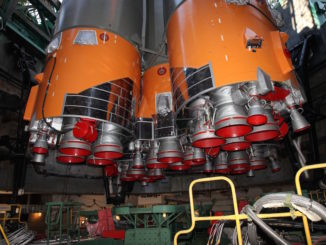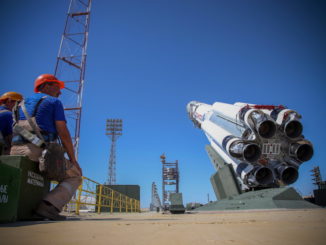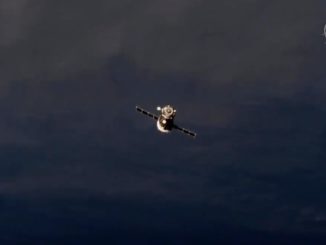STORY WRITTEN FOR CBS NEWS & USED WITH PERMISSION
Two days after launch from Kazakhstan, a Russian Soyuz ferry ship glided to a smooth docking with the International Space Station Saturday, bringing a veteran cosmonaut, a Frenchman making his first flight and NASA’s most experienced female astronaut to the lab complex.
With commander Oleg Novitskiy at the controls, flanked on the left by European Space Agency flight engineer Thomas Pesquet and on the right by NASA’s Peggy Whitson, the Soyuz MS-03/49S spacecraft moved in for a docking at the Earth-facing Rassvet module at 4:58 p.m. EST (GMT-5).
After extensive leak checks to verify structural integrity and an airtight seal, hatches were opened just after 7:30 p.m. and the crew was welcomed aboard by Expedition 50 commander Shane Kimbrough, Soyuz MS-02 commander Sergey Ryzhikov and Andrey Borisenko, who were launched to the station Oct. 19.
Floating in the Russian Zvezda module, the combined six-member crew held a traditional video conference with program managers, family and friends gathered at the Russian mission control center near Moscow.
“Hello, Dad, how are you,” Novitskiy’s daughter radioed.
“How are you, did you cry much?” he asked.
“No crying at all.”
“Well, I was hoping someone would cry!” Novitskiy joked.
“We were all worried, of course, but we were being brave,” his daughter said.
Novitskiy’s grandmother called up her congratulations, saying “we, the earthlings, need to follow your example, we need to all love each other. Good health to you and your crew and your colleagues. … We’ve started the countdown to your landing!”
This is Novitskiy’s second trip to the station. He spent 144 days at the laboratory in 2012-13. Whitson, 56, is a veteran of two long-duration stays in 2002 and 2007-08 totaling nearly 377 days. She served as commander of the station during her second visit and later served as chief of NASA’s astronaut office at the Johnson Space Center.
On April 24, Whitson will set a new record for most time in space by a U.S. astronaut, surpassing the 534-day mark set in September by astronaut Jeff Williams.
“She is an absolutely incredible role model for women everywhere in the world, and I could not be more proud to be able to call her a friend and colleague,” NASA Administrator Charles Bolden, a former shuttle commander, said from the Russian mission control center where he watched the docking.
Bolden took a moment to mark the 18th anniversary of the first space station launch, saying the outpost stands as an example of international cooperation that will help pave the way for eventual missions beyond Earth orbit.
“We’re going to use it to the best of our ability, maximize its utilization to learn as much as we can about the human body and about technologies necessary to get humans to Mars,” he said. “That’s what we’re doing.”
As for increased tensions between Washington and Moscow, Bolden said he was confident the space station project would continue to weather “the political and diplomatic changes and trauma that go on down here on Earth.”
Even “incursions by one of our partners into other countries, that has not deterred or slowed the work that we’ve done on the International Space Station,” he said, in a not-so-veiled reference to Russia’s actions in Crimea. “I look to that to be the case for years to come.”
Whitson and her crewmates face a particularly busy mission, with a full slate of scientific research, at least two spacewalks and multiple visiting vehicle arrivals and departures.
This first of those is on tap Monday when an Orbital ATK Cygnus cargo ship loaded with trash and no-longer-needed equipment is detached from the station by the lab’s robot arm.
After moving a safe distance away, the spacecraft will operate autonomously while an untended experiment is carried out in its pressurized cabin to learn more about how flames propagate in weightlessness. The Cygnus then will be commanded to plunge back into the atmosphere, burning up harmlessly over the Pacific Ocean.
The station crew will welcome a Russian Progress cargo ship in two weeks and a Japanese HTV freighter on Dec. 13. The HTV is loaded with six state-of-the-art lithium-ion batteries that will replace 12 aging nickel-hydrogen batteries in one set of the station’s solar arrays. They will be installed during at least two spacewalks in January.
A SpaceX Dragon cargo ship is expected to arrive in late January, followed by another Progress in early February, another Cygnus later that month and another Dragon in early March. The SpaceX dates assume the company completes its recovery from a Sept. 1 launch pad explosion that destroyed a Falcon 9 rocket.
Additional spacewalks are planned in the spring to attach a short tunnel-like pressurized mating adapter to a port on the forward Harmony module that eventually will be used by commercial crew ships being built by Boeing and SpaceX. One such port already is attached to the front of the station.
Kimbrough, Ryzhikov and Borisenko are scheduled to return to Earth in late February. They will be replaced by Soyuz MS-04 commander Fyodor Yurchikhin and NASA astronaut Jack Fischer, the first of two two-person ferry flights now planned for 2017. Launch is targeted for March 27.
Whitson’s crew plans to wrap up their stay aloft in May, landing in Kazakhstan around the middle of the month. They will be replaced by another three-person crew made up of Soyuz MS-05 commander Sergey Ryazanskiy, European Space Agency astronaut Paulo Nespoli and NASA astronaut Randy Bresnik. That launch is planned for May 29.



